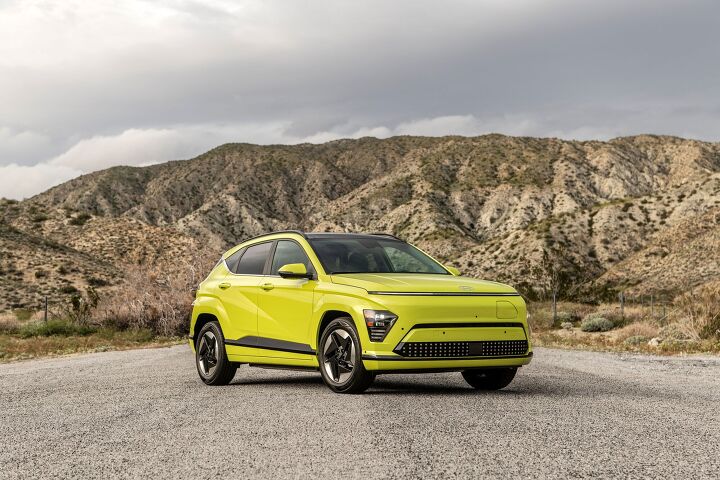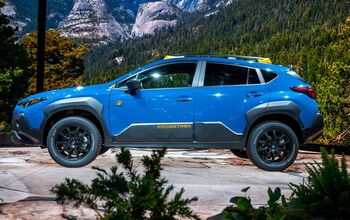2023 NY Auto Show: Hyundai Introduces 2024 Kona

Hyundai took the covers off three variants of its new Kona today, unveiling the standard and N-Line trims plus a continuation of the all-electric model – the latter of which Hyundai will now offer with two battery sizes.
In an unusual decision, Hyundai developed the Kona’s new platform with an electrified powertrain before the gassers. This aligns with the company’s accelerated electrification strategy announcement which will bring nearly a dozen new Hyundai EVs to the global market by 2030. Might as well start with that one, then.
The new Kona Electric packs a 64.8-kWh battery, roughly the same as last year’s car, good for an estimated 260 miles of range, and paired with a 201-horsepower electric motor. Interestingly, there will also be a smaller battery on offer, sized at 48.6-kWh and carrying the car just slightly less than 200 miles on a full charge. Only 133 horses are on tap in this trim, which doesn’t sound like much because it isn’t. Perhaps this trim will simply be a price leader to get people in the door, at which point someone with hair gel will upsell them to the bigger one.
Gassers will come with a choice of four-banger engines. Entry-level trims get a 2.0-liter mill making 147 ponies and 132 lb-ft of twist whilst Limited and N-Line trims earn a turbocharged 1.6L unit with 190 horsepower and 195 torques. The turbo ditches last year’s dual-clutch for an eight-speed automatic. All-wheel drive is an option for those who feel the need.
It’s bigger, too. The Kona is now 171.3 inches long, an increase of 5.7 inches and only half a foot less than the original Santa Fe. Wheelbase is up 2.3 inches to 104.7 (which sounds like a radio station), and the thing is a full inch wider than its predecessor. Hyundai brags of more cargo space – now 25.5 cubic feet with the rear seats up – and extra room for rear seat passengers compared to the old car.
The new exterior styling will not have escaped anyone’s notice, though we cannot fathom why Hyundai insists on placing the EV’s charging port in such a prominent location. Inside we find dual 12.3-inch panoramic display screens, though it’s not immediately clear if they are standard across the board. Note the new shifter, cribbed from the IONIQ 5, a column-mounted device that is rapidly making its way across the entire Hyundai lineup in both gasoline-powered and all-electric models.
Look for the 2024 Kona to arrive at U.S. dealers this summer, with the Kona Electric showing up in late autumn.
[Images: Hyundai, © 2023 Chris Tonn/TTAC]
Become a TTAC insider. Get the latest news, features, TTAC takes, and everything else that gets to the truth about cars first by subscribing to our newsletter.

Matthew buys, sells, fixes, & races cars. As a human index of auto & auction knowledge, he is fond of making money and offering loud opinions.
More by Matthew Guy
Latest Car Reviews
Read moreLatest Product Reviews
Read moreRecent Comments
- Wjtinfwb Nice car and looks well cared for. The accessories are mostly for vanity, their value is in the eye of the buyer. I see zero value in them but I like bone stock if buying used. The problem this seller has is his spec is not at all unique; not a manual, no Shaker hood, attractive, but conservative color. Today, AutoTrader has 130 used 2015-2018 Challenger Hemi's with automatics available. The average price is abut 27,200 and mileage is slightly lower than this example at about 40k miles. Almost all are at dealers where a decent negotiator should be able to knock $1500-2500 off the ask. This is a 25k car, the buyer may not believe it but stats would say otherwise.
- Turbo Is Black Magic Honestly at this point Elon is more of a liability than an asset. How much does the board have to pay to just get rid of him?
- FreedMike The article touches on this fact, but the number of public EV chargers grew by over 18,000 between 2021 and 2023. https://afdc.energy.gov/fuels/electricity-infrastructure-trendsSo clearly the expansion is happening without the use of the funds in question. Not necessarily a bad thing, if you're into not using taxpayer money. Still, I'd be interested in knowing why the public money isn't being used. Are the regs overly complex or restrictive, or something like that? But in any case, EV charging IS expanding at a pretty solid rate. And as far as "...we’ve seen plenty of Republican-backed legislation targeting EV-related spending over the last couple of years" is concerned...well, yeah, there's a reason why Republicans don't like EV charging. The petroleum industry is one of the GOP's prime donors, and every charger built or EV sold represents a direct ding to their bottom line. Republicans, of course, like to put this in terms of "EVs are a woke mind virus," or some such nonsense, but the fact is that the people paying their bills don't want competition.
- 28-Cars-Later When its discontinued.
- NigelShiftright If this boondoggle had worked, we'd have half a million charging stations with no generating capacity to speak of.












































Comments
Join the conversation
At least that black plastic trimming is gone.
I thought the previous version had more character. This one is rather bland. I agree it is stupid placement for the electric charger port.